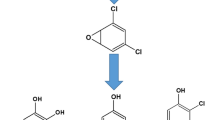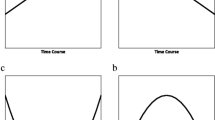Summary
The relatively high and almost constant absorption/min of trichloroethylene (TRI) is explained by the relatively high partition coefficient between blood and air (λb/g = 15) combined with the rapid metabolism (75 %). Tetrachloroethylene (PERC) has about the same λb/g as TRI, but the metabolism is insignificant (2 %); therefore, the amount taken up/min decreases in the course of exposure. The λb/g (5) for 1,1,1-trichloroethane (MC) is smaller, the metabolism is insignificant (3.5 %), therefore the capacity of the body to absorb MC is relatively small and in consequence the uptake/min decreases fast in the course of exposure. Due to the lower λb/g the excretion of MC after exposure is much faster than of PERC. As a result of the metabolism of TRI only a relatively small amount of TRI absorbed is excreted by the lungs after exposure.
Similar content being viewed by others
References
Daniel, J. W.: The metabolism of 3601-labelled trichloroethylene and tetrachloroethylene in rat. Biochem. Pharmacol. 12, 795–802 (1963)
Eger, E. I.: Mathematic model of uptake and distribution. In: Uptake and distribution of anesthetic agents; ed. by E. M. Papper and R. J. Kite, pp. 77–103. New York: McGraw-Hill 1963
Leibman, K. C.: Metabolism of trichloroethylene in liver microsomes. 1. Characteristics of the reaction. Mol. Pharmaol. 1, 237–246 (1965)
Marshall, E. K., Owens, A. H.: Absorption, excretion and metabolic fate of chloralhydrate and trichloroethanol. Bull Johns Hop. Hosp. 95, 1–18 (1954)
Monster, A. C., Boersma, G., Duba, W. C.: Pharmacokinetics of trichloroethylene in volunteers; influence of work load and exposure concentration. Int. Arch. Occup. Environ. Health 38, 87–102 (1976)
Monster, A. C., Boersma, G., Steenweg, H.: Kinetics of 1,1,1-trichloroethane in volunteers; influence of exposure concentrations and work load. Int. Arch. Occup. Environ. Health 42, 293–301 (1979a)
Monster, A. C., Boersma, G., Steenweg, H.: Kinetics of tetrachloroethylene in volunteers; influence of exposure concentration and work load. Int. Arch. Occup. Environ. Health 42, 303–309 (1979b)
Monster, A. C., Boersma, G., Duba, W. C.: Kinetics of trichloroethylene in repeated exposure of volunteers. Int. Arch. Occup. Environ. Health 42, 283–292 (1979c)
Morgan, A., Black, A., Belcher, D. R.: Studies on the absorption of halogenated hydrocarbons and their excretion in breath using 38Cl tracer techniques. Ann. Occup. Hyg. 15, 273–282 (1972)
Müller, G., Spassovski, M., Henschler, D.: Metabolism of trichloroethylene in man. II. Pharmacokinetics of metabolites. Arch. Toxicol. (Berl.) 32, 283–295 (1974)
Rees, H. van: De respiratoire opname van niet-inerte gassen en dampen. Proefschrift. Leiden 1964
Sherwood, R. J.: Oswald solubility coefficients of some industrially important substances. Br. J. Ind. Med. 33, 106–107 (1976)
Steward, A., Allott, P. R., Cowles, A. L., Mapleson, W. W.: Solubility coefficients for inhaled anaesthetics for water, oil and biological media. Br. J. Anaesth. 45, 282–293 (1973)
Waters, E. M., Gerstner, H. B., Huff, J. E.: Trichloroethylene. I. An overview. J. Toxicol. Environ. Health 2, 671–707 (1977)
Yllner, S.: Urinary metabolites of 14C tetrachloroethylene in mice. Nature 191, 820 (1961)
Author information
Authors and Affiliations
Rights and permissions
About this article
Cite this article
Monster, A.C. Difference in uptake, elimination, and metabolism in exposure to trichloroethylene, 1,1,1-trichloroethane and tetrachloroethylene. Int. Arch Occup Environ Heath 42, 311–317 (1979). https://doi.org/10.1007/BF00377785
Received:
Accepted:
Issue Date:
DOI: https://doi.org/10.1007/BF00377785




